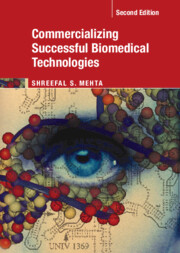Book contents
- Commercializing Successful Biomedical Technologies
- Commercializing Successful Biomedical Technologies
- Copyright page
- Dedication
- Contents
- Preface
- Acknowledgments
- 1 The biomedical device and drug industry and their markets
- 2 Markets of interest and market research steps
- 3 Starting up your company
- 4 Intellectual property and licensing
- 5 New product development (NPD)
- 6 The regulated market: gateway through the FDA
- 7 Manufacturing
- 8 Reimbursement, marketing, sales, and product liability
- Glossary
- Index
- References
6 - The regulated market: gateway through the FDA
Published online by Cambridge University Press: 03 November 2022
- Commercializing Successful Biomedical Technologies
- Commercializing Successful Biomedical Technologies
- Copyright page
- Dedication
- Contents
- Preface
- Acknowledgments
- 1 The biomedical device and drug industry and their markets
- 2 Markets of interest and market research steps
- 3 Starting up your company
- 4 Intellectual property and licensing
- 5 New product development (NPD)
- 6 The regulated market: gateway through the FDA
- 7 Manufacturing
- 8 Reimbursement, marketing, sales, and product liability
- Glossary
- Index
- References
Summary
From the long path through preclinical development, entering the regulatory field of interactions for human clinical trials can sometimes feel like you are walking into the lion’s den. This chapter guides you through an understanding of how to interact and how to prepare for FDA meetings so that they are on your side rather than fighting you. The common goals of companies and the FDA are highlighted here. Specific issues with identifying the appropriate regulatory approval pathway are discussed here with cautionary case studies. Complex new technologies which combine diagnostics and drugs, or devices and software, or AI-based dynamic software are reviewed here. The best approach to the appropriate regulatory pathway will be clear after reading this chapter. Case studies are used to show successful pathways taken by cutting-edge developments, such as cell-based therapy.
Keywords
- Type
- Chapter
- Information
- Commercializing Successful Biomedical Technologies , pp. 239 - 308Publisher: Cambridge University PressPrint publication year: 2022



